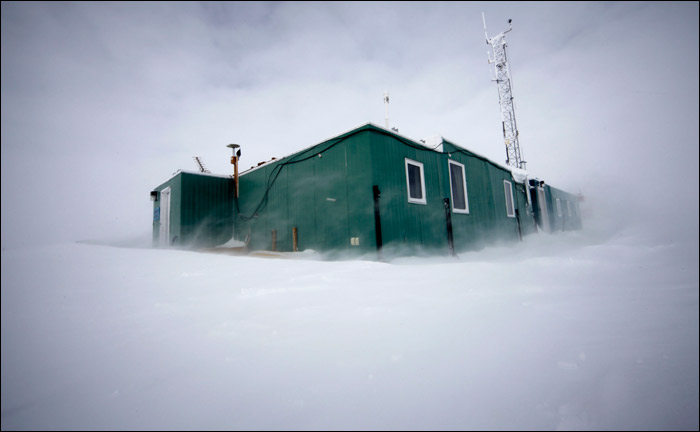home | internet service | web design | business directory | bulletin board | advertise | events calendar | contact | weather | cams

| Summit Station Working on Greenland's Ice Cap 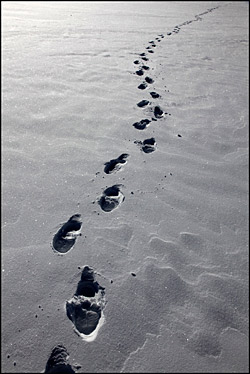 Footsteps to everywhere. Footsteps from nowhere. Footsteps to nowhere. Footsteps to everywhere. Footsteps from nowhere. Footsteps to nowhere. Ed Stockard is working at 10,530 elevation on top of 10,016 feet of ice at the summit of Greenland’s ice cap. It’s plenty cold at the Summit Station, where he is serving this season as the station mechanic, attending to two diesel generators and a third emergency diesel generator plus being responsible for fuel, a water melting system, heavy and light equipment and general building utilities.
Three of the five people at Summit Station are scientific researchers, which means Stockard and this year’s manager share duties and collaborate on projects and issues that support the scientists and keep everyone alive. In the late spring through summer, when most research is under way, the station population can grow to 40 people. 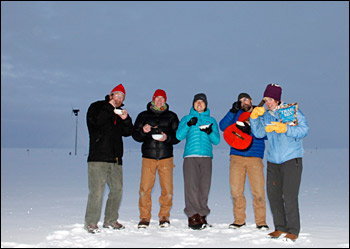 The Summit Station crew celebrates August 31, designated ‘National Eat Outside Day’ by someone not living at Summit Station. The Summit Station crew celebrates August 31, designated ‘National Eat Outside Day’ by someone not living at Summit Station.
Stockard said the human factor can be intense too. ”Living in close quarters with a handful of others you don't choose at times challenges ones self.” He said during his last two stints at Summit Camp he’s worked with “wonderful folks with like attitudes and energy to get each other through long cold days and nights. We literally trust our lives to each other.” 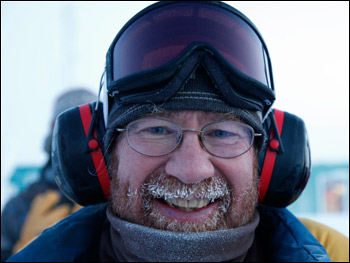 Ed Stockard geared up for the outdoors at Summit Station
Ed Stockard geared up for the outdoors at Summit StationStockard expects to be back in the Methow by mid-November, weather cooperating. He has racked up more than five years in Greenland, which includes over a year in the harsh climate and great beauty of the ice cap. “The ice sheet, the Arctic and the Antarctic are uniquely beautiful. The everyday beauty of the Methow is always wonderful to come home to, but the sights I see here are other-worldly. Subtle shades of blues or pastels sharpen ones senses. The endless horizon is humbling. Since my return to Summit a year ago last August, I have seen and photographed optical phenomena that can be only found in extreme polar regions. Photography has me gripped.” Stockard’s photographs have been published in various books and websites. Most recently, Optics Photo(s) of the Day have published photos with explanations of various sightings: lunar sightings; halos and arcs; and full-sky images of rarely seen or photographed halos. Last year spaceweather.com picked up a few aurora photos. A Finnish expert on halos recently told Stockard his photographs were adding to halo history. Stockard said he came to live in the Methow a few years after buying property in the late 1970’s. “I was on the ski area bandwagon which I now look back at, and am thankful the valley survived without a major resort.” He worked seventeen years of mostly full time employment at Washington ski areas, which led to the Antarctic job offer in 1993. “I moved from Roslyn, Washington soon after and built my home after spending a full year ‘on the ice’. I had to go back for another fourteen months to sink more cash into the home,” he said. Stockard met his wife, Torre, in 1999 in Antarctica. “We married in 2002,” he said. “She was studying emperor penguins and that led me to one of the more interesting jobs--ranching penguins--along with taking care of her sea ice camp called “Penguin Ranch.” 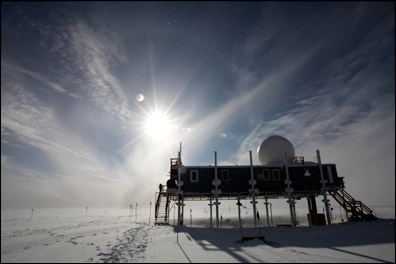 Mid-day September 14 at Summit Station. Mid-day September 14 at Summit Station.He must not be able to get enough of the cold. “For the last few winters I have been grooming trails for the Methow Sport Trail Association and I plan to continue with that.” To find out more about Ed Stockard, his work in Greenland, and his Arctic photographs, visit: summitcamp.org and flickr.com/photos/coastaleddy posted 09/20/2011 |
